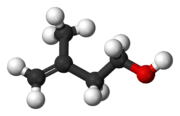Isoprenol
Isoprenol, also known as 3-methylbut-3-en-1-ol, is a hemiterpene alcohol. It is produced industrially as an intermediate to 3-methylbut-2-en-1-ol (prenol): global production in 2001 can be estimated as 6–13 thousand tons.[3]
 | |
 | |
| Names | |
|---|---|
| IUPAC name
3-Methylbut-3-en-1-ol | |
| Other names
3-Methyl-3-buten-1-ol | |
| Identifiers | |
3D model (JSmol) |
|
| ChEBI | |
| ChEMBL | |
| ChemSpider | |
| ECHA InfoCard | 100.011.009 |
| EC Number |
|
PubChem CID |
|
| UNII | |
CompTox Dashboard (EPA) |
|
| |
| |
| Properties[1] | |
| C5H10O | |
| Molar mass | 86.132 g/mol |
| Density | 0.853 g/cm3 |
| Boiling point | 130 to 132 °C (266 to 270 °F; 403 to 405 K) |
Refractive index (nD) |
1.433 |
| Hazards[2] | |
| GHS pictograms |   |
| GHS Signal word | Warning |
GHS hazard statements |
H226, H319 |
| P210, P233, P240, P241, P242, P243, P264, P280, P303+361+353, P305+351+338, P337+313, P370+378, P403+235, P501 | |
| Flash point | 36 °C (97 °F; 309 K)[note 1] |
| Related compounds | |
Related compounds |
Prenol |
Except where otherwise noted, data are given for materials in their standard state (at 25 °C [77 °F], 100 kPa). | |
| Infobox references | |
Isoprenol is produced by the reaction between isobutene (2-methylpropene) and formaldehyde.

The reaction of isobutene with formaldehyde to give isoprenol, the first step in the industrial manufacture of prenol.
The thermodynamically preferred isomer with the more substituted double bond cannot be directly formed in this reaction, but isomerization yields the desired product:

The isomerization of isoprenol to prenol, the second step in the industrial manufacture of prenol.
The reaction is catalyzed by any species which can form an allyl complex without excessive hydrogenation of the substrate, for example poisoned palladium catalysts.[4]
Notes
- Sigma-Aldrich Co. gives a value for the flash point of isoprenol of 42 °C (108 °F). The difference in the two values does not alter the safety classification of isoprenol as a category 3 flammable liquid under the GHS; but the lower value quoted here (from the New Zealand Environmental Risk Management Authority) would make it a class IC flammable liquid instead of a class II combustible liquid under the U.S. OSHA classification (29 C.F.R § 1910.106), and F3 rather than F2 under the NFPA 704 standard.
gollark: Okay, that... broke?
gollark: I forgot C doesn't ACTUALLY make sense.
gollark: ++exec -L c-gcc```cint main(int apiohazard, char* *apioform) { char buf[1024]; printf("%s", buf); return 3333;}```
gollark: Hmm. Troubling.
gollark: ++exec -L c-gcc```cint main(int apiohazard, char* *apioform) { char[1024] buf; printf("%s", buf); return 3333;}```
References
- Sigma-Aldrich Co., 3-Methyl-3-buten-1-ol. Retrieved on 2009-08-31..
- HSNO Chemical Classification Information Database, New Zealand Environmental Risk Management Authority, retrieved 2009-08-31.
- 3-Methyl-2-buten-1-ol (PDF), SIDS Initial Assessment Report, Geneva: United Nations Environment Programme, May 2005. Major produce in a world is BASF(Germany) and Kuraray(Japan).
- See, e.g., Kogan, S. B.; Kaliya, M.; Froumin, N. (2006), "Liquid phase isomerization of isoprenol into prenol in hydrogen environment", Appl. Catal. A: Gen., 297 (2): 231–36, doi:10.1016/j.apcata.2005.09.010.
This article is issued from Wikipedia. The text is licensed under Creative Commons - Attribution - Sharealike. Additional terms may apply for the media files.